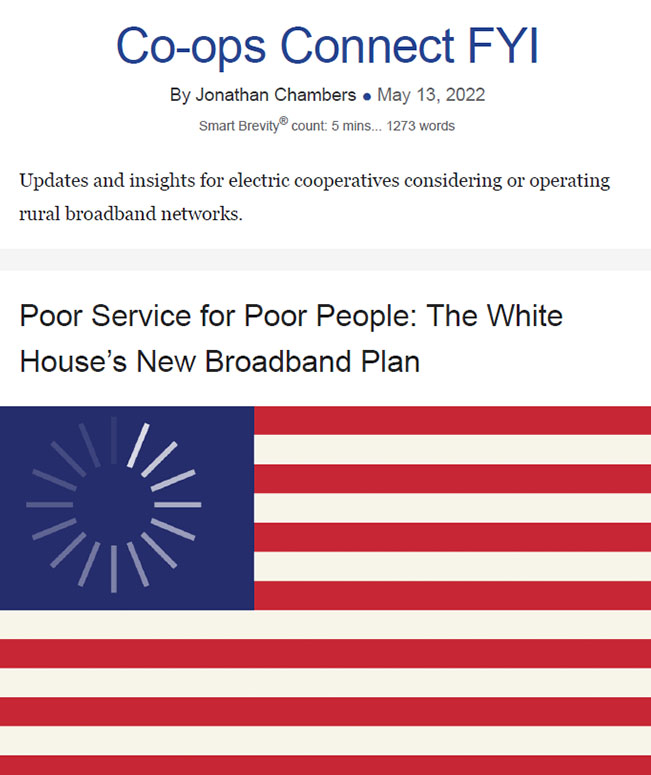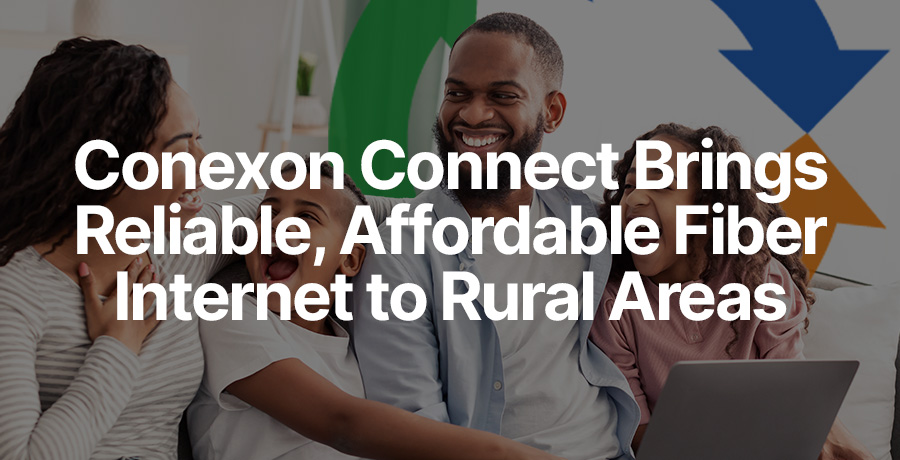Poor Service for Poor People: The White House’s New Broadband Plan
May 13, 2022
At a White House ceremony earlier this week, the president and his administration gathered to repackage a program that was enacted last year: the Affordable Connectivity Program.
I am a fan of the ACP, as readers of this newsletter know. I think more can be done with the program to alleviate poverty by directing the enhanced broadband subsidy to persistent poverty counties.
But:
The Biden Administration must believe it hasn’t been getting enough credit for the ACP.
In its recent promotional efforts, it has crossed several lines.
1. It is seldom a good idea for the government to become a market participant, especially by becoming a sales agent for companies it regulates.
2. In this case, the White House is promoting a damaging idea: that rural areas and low-income households should make do with lesser broadband.
Go deeper:
The White House gathering this week wasn’t simply a celebration of the $30 monthly subsidy program.
- Over recent weeks and months, the Biden Administration had cajoled and strong-armed 20 of the nation’s thousands of ISPs to offer a special broadband service that would cost less than $30 per month.
- In this way, coupled with a $30 subsidy, these 20 companies could offer broadband for … FREE.
- These 20 companies now appear on a special government website. (I’m not going to promote it here.)
Why it matters:
Every sentient being knows and understands free.
- We grew up with such marketing gimmicks: give away the razors, sell the blades.
- We know that Google’s algorithms use our free search or free Gmail to sell us out to advertisers, sometimes in creepy ways. (I once received an email from a friend with breast cancer and started receiving ads for plastic surgery.)
- We all pay the cost of free public money. Free government money contributes to inflation. It’s always a balancing act.
What’s next:
Not everyone tracks free telecommunications service, so below is a short primer.
1. Free government telecommunications services have been bedeviled with fraud.
The FCC has struggled to contain fraud in every one of its spending programs: Emergency Broadband Benefits, Lifeline, E-rate,Telecommunications Relay Services, High-Cost Funds.
Not just a little fraud and not just by little players: Tens and hundreds of millions of dollars in fraud leading to investigations and settlements between the FCC/Justice Department and AT&T, Verizon/Tracfone, T-Mobile/Sprint, and New York City, just to name a few.
There are worthy programs established to help deserving segments of society.
- But the design of some of these programs undermines the worthy cause.
- And one design flaw outshines all others: Free leads to fraud.
A bit of history:
Lifeline was once a sleepy regulatory assistance program, which made plain old telephone service a bit more affordable by providing a subsidy to low-income households.
Then, at the tail end of the Martin FCC, Tracfone was granted a waiver to participate in Lifeline as a reseller of mobile phone service.
- At the time, the Lifeline subsidy was $9.25 per month.
- And, at the time, Tracfone’s ARPU was between $9 and $10 per month.
- Within a few years, Tracfone and scores of copycat wireless resellers were offering free mobile phone service.
Free phones, free service. The Lifeline program exploded.
- Phones were being given away out of the trunks of cars in parking lots.
- Over 95 percent of all the new accounts in the Lifeline program were free wireless plans.
- In Oklahoma, where the enhanced tribal land subsidy is $34.25 per month, the number of subsidized accounts was, at one point, approaching the number of households in the state.
Why it matters:
- The Obama Administration got a bad rap for promoting so-called Obama phones, when the Bush Administration had been at fault.
- The fraud nearly destroyed the program.
- I’m sure those on the Rosenworcel team will tell you that they learned the mistakes of their predecessors.
- Then again, the Emergency Broadband Benefits program had only been a few months old when the FCC Inspector General announced that the program was already beset with fraud.
2. Broadband for me, but not for thee.
The Biden Administration started out on exactly the right path with broadband.
- It promoted fiber networks and high-speed internet access with symmetrical upload and download speeds.
- This was a welcome contrast to the activities of prior administrations, which often treated broadband as a minimum, “good enough” service for rural and low-income households.
- In the words of one misguided former Republican FCC Commissioner, rural America doesn’t need Lamborghinis when it comes to broadband. He considered anything better than 4 Mbps Lamborghini-fast.
At Conexon, we only serve rural America, and we serve some of the poorest parts of the country.
- One-third of our customers subscribe to 2 Gbps symmetrical internet access.
- Rural Americans, even low-income households, choose the highest speeds available.
The bottom line: The question is affordability, not free.
- Free distorts the marketplace. Free in one place inflates prices somewhere else.
- When I was at the FCC, I once proposed – and still believe that – the low-income programs should not lead to free service. A monthly fee, as little as $5-10, is important to remove the distortions.
The Biden folks who had been good on broadband policy are now promoting service they don’t consider broadband – because it’s free to poor folk.
3. Cheap service doesn’t build quality networks in rural areas.
I have written previously about the need for quality networks in persistent poverty counties and the role that the ACP could play. The Biden team is now pushing in the opposite direction.
Let’s revisit the case of East Carroll Parish, once dubbed by the New York Times as the poorest place in the country.
- According to the Census, there are 1,688 households in East Carroll, approximately 200 road miles, and the median household income is $22,346.
- Nearly every household in East Carroll qualifies for the ACP.
We plan to build a fiber network to every household in East Carroll.
By the numbers:
- Even a very efficient build of $35,000 per mile would be a $7 million construction project for mainline fiber.
- Add electronics, connectivity equipment, service drops, installation costs for, say, 1,200 customers, or about $2.5 million. Add the cost of capital.
- In other words, a service provider would need to generate well over $10 million in revenue net of operating expenses before it recovers its capital expenditure.
Go deeper:
An equity investor or lending institution wouldn’t greenlight such a project without $80,000 or $90,000 in monthly EBITDA. $30 in revenue per month per household is not enough to build a fiber network in East Carroll Parish.
The big picture:
$30 in revenue per month per household is not enough to build a fiber network anywhere in rural America.
It's not close. It’s nowhere near close. A service provider needs to be showing average revenue per customer closer to $75 per month.
What does the average co-op member pay for electricity? Not $30 per month. The ACP is a critical program to make service affordable, not free.
The bottom line:
Lower quality, free service undermines the business case for high-quality networks in poorer, rural areas.
Final Thoughts
Nearly all the persistent poverty counties in the country are served by electric co-ops.
When policymakers point to electric co-ops as the model for rural broadband, they seem to miss the economics.
- Electricity isn’t free and electric networks aren’t supportable with $30 per month per household.
The bottom line:
In a similar context, Michael Gerson once wrote of “the soft bigotry of low expectations.”

